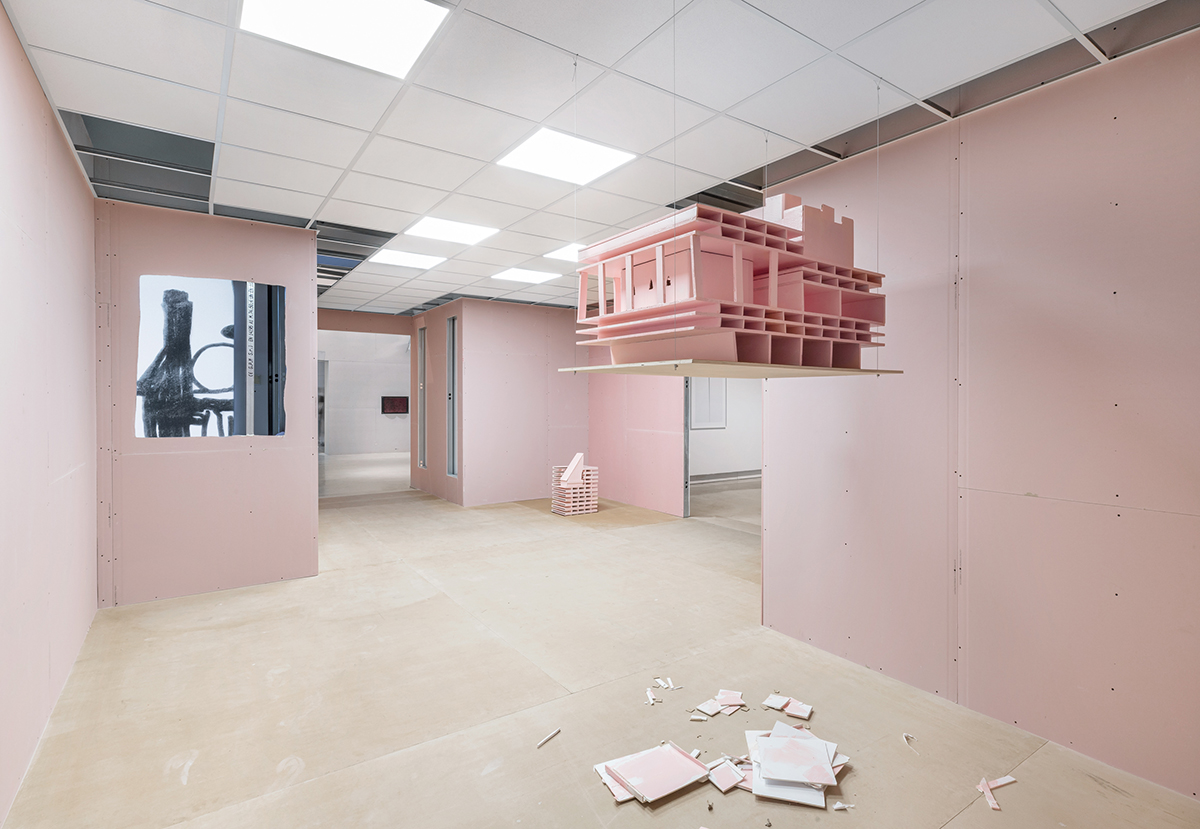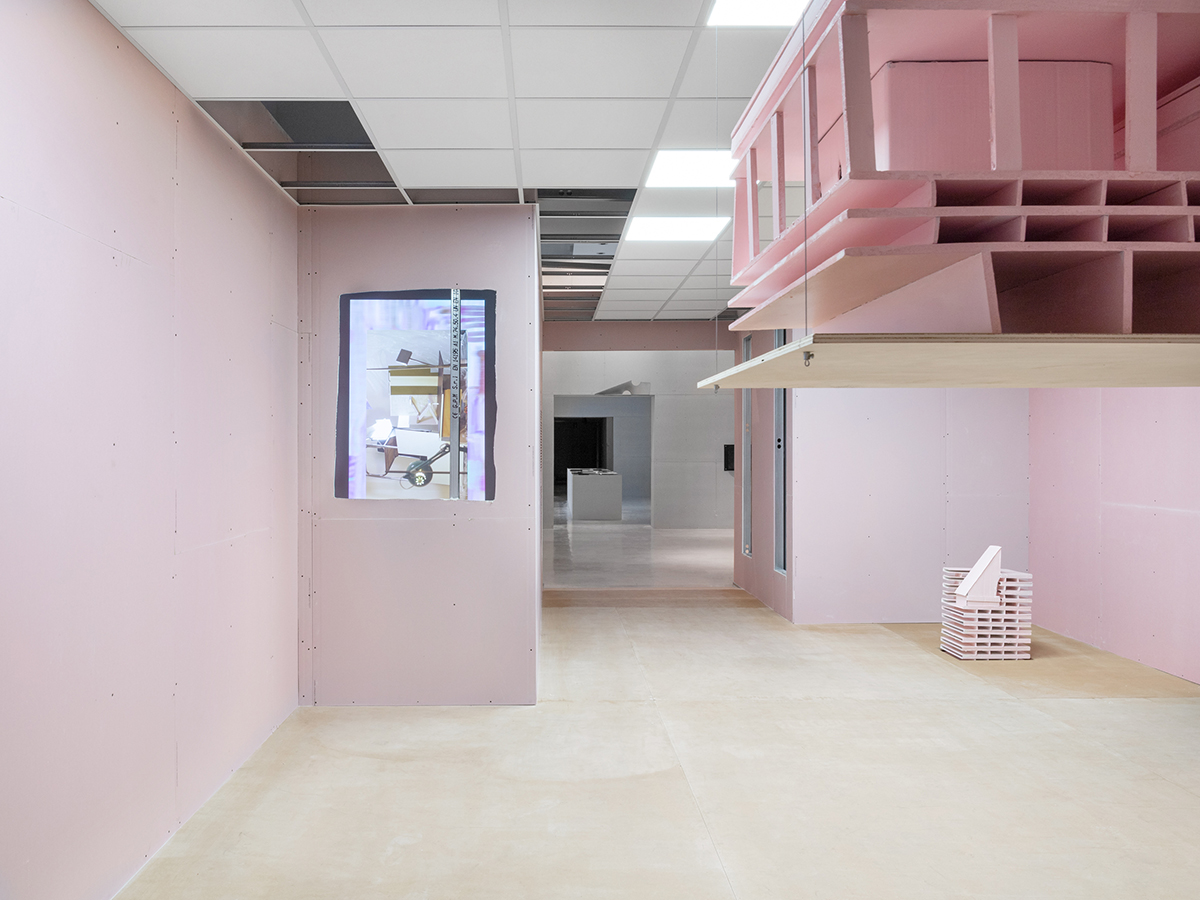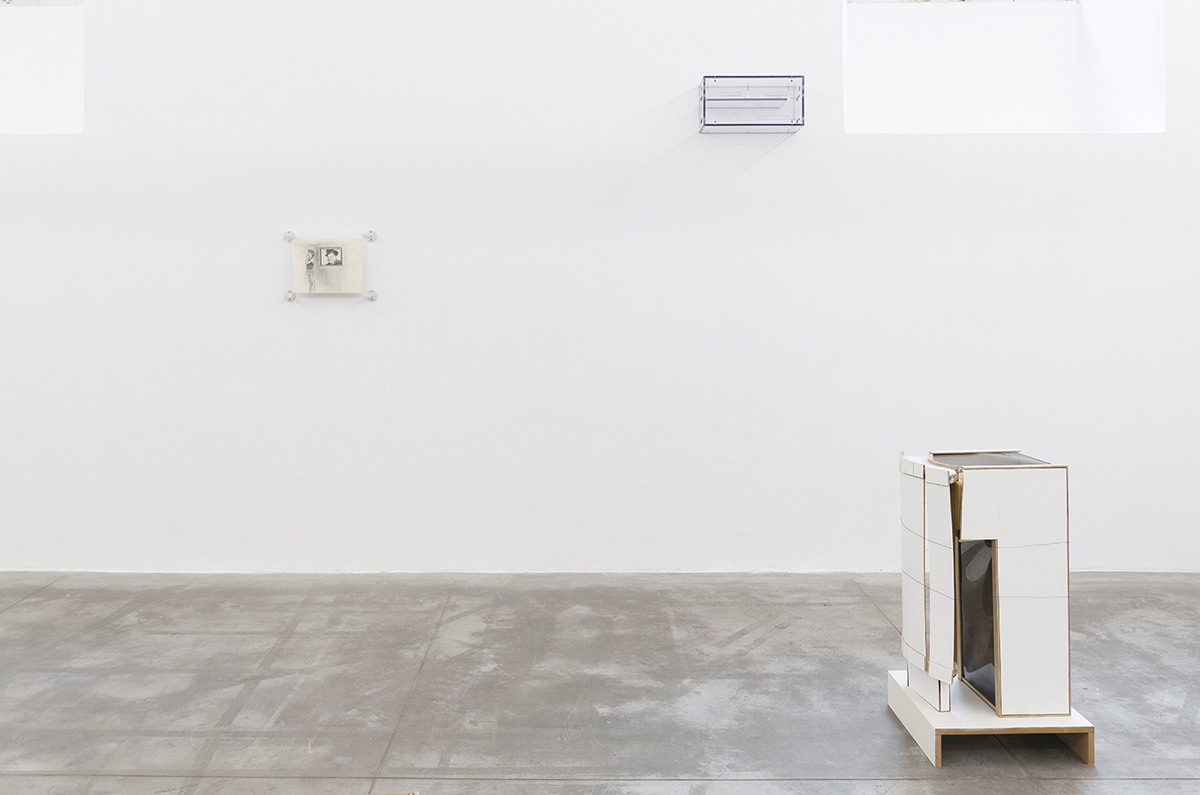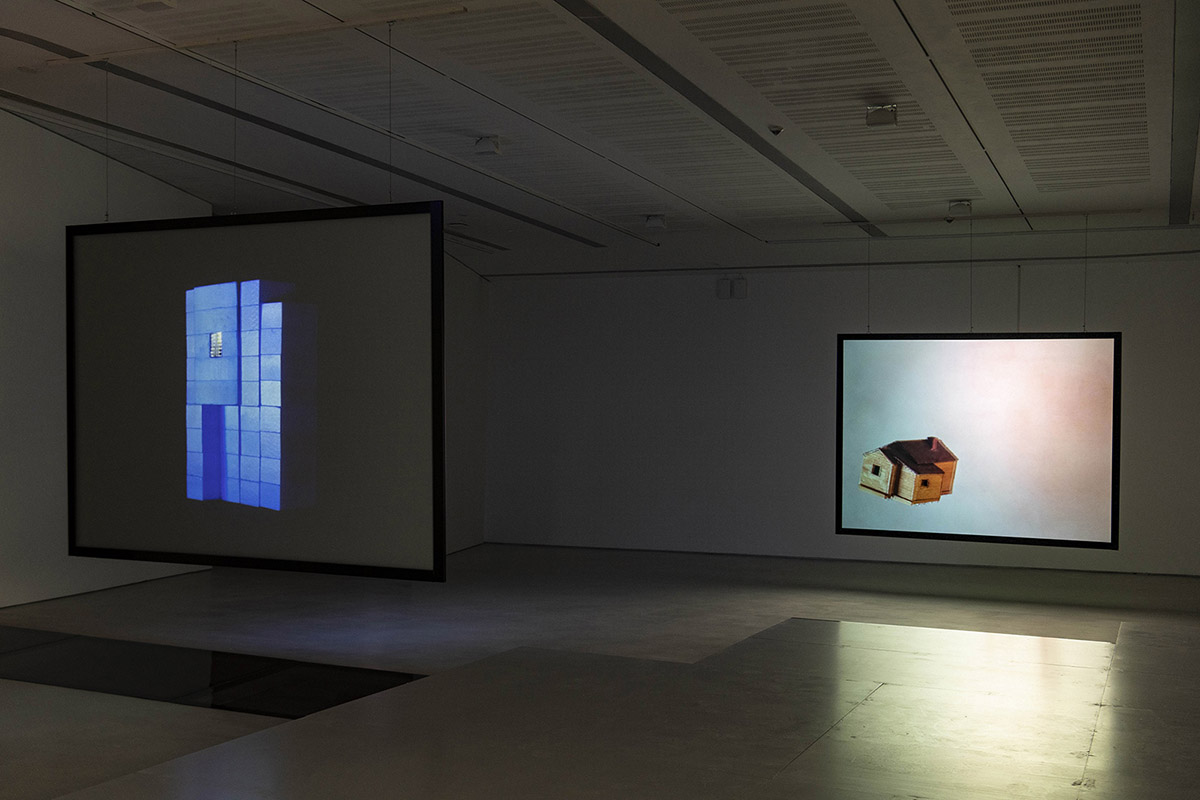Tomaso De Luca was the 2017 Cy Twombly Italian Fellow in Visual Arts at the American Academy in Rome, where he participated in that year’s edition of Cinque Mostre, titled Vision(s) :. Born in Verona in 1988, he studied in Milan and lives and works in Berlin. Recent group exhibitions in Rome include Fuori! (Quadriennale d’arte, October 30, 2020–May 2, 2021) and We Don’t Like Your House Either!, curated by Francesco Urbano Ragazzi (Monitor, September 25–November 20, 2020). Tomaso’s work has been featured in solo shows in Rome, Turin, New York, Bremen, and Zürich. He is a finalist for the MAXXI Bulgari Prize 2020 (MAXXI, October 28, 2020–May 2, 2021).
Tomaso is interviewed by Leslie Cozzi, the 2018 Andrew W. Mellon Foundation/National Endowment for the Humanities Post-Doctoral Fellow in Modern Italian Studies at the American Academy in Rome. A specialist in postwar and contemporary Italian art, she is presently associate curator of prints, drawings, and photographs at the Baltimore Museum of Art.
Leslie Cozzi: For your current Quadriennale installation, Die Schlüssel des Schlosses, or The Keys to the Castle, you’ve created an unfinished space populated by makeshift models. How did you create these models, which evoke both medieval and modernist architecture, and how do they embody a critique of institutions?
Tomaso De Luca: The models are created following a formal and rather intuitive process: they’re not planned or designed in advance, avoiding any transposition from drawing to sculpture. I rather employ a methodology that is a crossover between these two. Building the architectural models with repetitive modules and plane shapes forces me to think of them at first exclusively as sculptures and then, when I achieve a certain “formal balance,” I like to maim, cut, and recompose them. The result is closer to a collage or a sketch, a reduction and approximation of certain architectural archetypes. The models turn out extremely whimsical and funny.
Creating models through this process allows me to think of them as objects with body-like qualities: I find a humorous sense of impotence when architecture loses its might and splendor and turns into a fallible thing.
I think the critique of the institutions that I’ve always attempted in my works takes place in this very loss of power that forms and structures experience through the process just described. Institutional power doesn’t occur exclusively within social interactions; it also becomes the way in which we perceive and feel. Institutions therefore establish a sentimental system, rather than just an economic and political one, by replacing agency and desire with the concept of value, then organizing the inner and outer world according to it. Architecture is not just the shell that contains institutional power; it is indeed a fundamental part of the institution itself, the very machine that shapes our perception. In Die Schlüssel des Schlosses I portray the castle, the quintessential architectural prototype of enclosure and protection, but I took the walls down. I exposed it. The might just disappears, turning the keys of the castle into the keys of the locker: the German word Schloss means both, leaving room for interpretation, turning something extraordinary into ordinary, and vice versa.

How did you conceive of the exhibition design as a whole? How might we interpret the placement of these objects within the space?
There are several reasons why I decided to create a work consisting of different “sections.” Firstly I wanted something that was in direct relation with Palazzo delle Esposizioni, an architecture within the architecture, that could also contain bodies and objects itself. That poses the first question about scale and reality. People would wander around the Palazzo and suddenly walk into a space that is wedged between a door and a wall, completely divorced from its surroundings: a pink construction site that suggests an architecture yet to be. Some of its features resemble an office space; some others a one-bedroom apartment or even a modernist pavilion. The structure covers about forty square meters, the size of my studio apartment in Berlin, in which I live and work. I really enjoyed the idea of building something that had an ambiguous function, similarly to my daily experience of space. Inside this vague architecture one would find the two models, one suspended from the ceiling and one slightly sunk in the wooden floor, while in the back, in a narrow space between the structure and the walls of the Palazzo, the images of a video animation would scroll outside a “window,” as a moving landscape. The video features the blueprints of Palazzo delle Esposizioni, a zenithal translation of the space. Since the whole architecture looks approximate, not unlike the models of castles that are shown in it, one would start wondering which one is the “real space.” Is it the one portrayed by the models? The one scrolling on the screen? The construction site? The Palazzo itself?
The work plays with different formal elements to mimic and mock the modernist exhibition design, where the features of the surrounding architecture are echoed in the artworks. That produces an interconnected flow rather than a series of isolated images and objects surrounded by a so-called neutral architecture. What I was aiming for was a dysfunctional modernist exhibition, where everything was quite inaccessible—the models are placed too high or too low, the video is almost hidden in a utility room, the perimeter of the architecture can never be fully seen. Besides questioning the reality of the space, one might now wonder why the access to that space is barred, what it is protecting and how we are allowed to experience it.
You create hypothetical architecture using multiple media including film, drawing, and sculpture. Do you see your work as a challenge to the notion of medium-specificity, or do you feel that each medium lends a unique element to the work?
Every one of my works develops naturally in its own way, and I often find a sense of freedom and happiness in engaging with different media. I cherish how this practice breaks down the singularity that is implied in the idea of the author, especially when different media overlap in a single work, producing a fragmentation, both of myself and the work. When it happens, it seems that the fetishist fixation for the singularity (the artist, the work of art, etc.) disappears, disconnecting the artwork from any form of identity, letting it be a tool, something that can be used to understand the world, rather than something that requires understanding. I acknowledge now that my practice needs different languages at once, that every medium informs the other. It’s a chain—a flow as I referred to it before—rather than a number of singularities.
When I work, I keep in mind that my ultimate task is to create alternative strategies to the sentimental and political system we call the institution. It doesn’t matter how ineffective these attempts are, as long as they attempt to provide us with the tools to free ourselves from oppression.

You see your work as disruptive and have compared it to guerilla action. How does the Quadriennale project challenge the status quo?
The work revolves around the idea of the siege of a castle, with “castle” as a visual synecdoche—a piece of the whole which acts as a fetish for the ideological forces contained within. In this vein, the ambiguity of the word Schloss functions perfectly. A castle is a space of power and exclusion, a self-sustaining architecture that provides every essential need, and to achieve this goal it organizes people and things according to their perceived value within that structure of power. It is also the museum in which I am exhibiting the work, an institution designed to legitimize and define what art is and is not through a similar mechanism. Contemporary corporations are headquartered in buildings that are not very far removed from medieval castles either (this work specifically takes its cue from the corporate buildings I saw while visiting Oakland, California, in January). What I wanted to focus on is the sense of belonging that the castle produces, a sense of belonging generated by accumulation of things, value, and property—organized by the hierarchies of perceived value. In Die Schlüssel des Schlosses I used the blueprints of Palazzo delle Esposizioni and tried to plan a siege, an attack that could lead anyone in the Palazzo. So I’d probably define it as a guerilla proposition rather than an action.
The reality is that I don’t see any challenge to the status quo in the premise of this work, meaning that its content will probably be understood and absorbed quite easily, with no outcome. Bourgeois ideology can subscribe to revolutionary ideas without actually affecting a change in behavior or taking any action; it ultimately looks at artworks as mere entertainment. The only “status quo” that I can be accountable for is probably mine.
The work was conceived during the COVID pandemic. How does the notion of apocalypse inform the project?
I was asked by Stefano Collicelli Cagol, curator of the Quadriennale 2020, to create a site-specific project for the show. I submitted the project in early May. At that time I was editing the videos of A Week’s Notice, the work I later presented at MAXXI Bvlgari Prize. I finished shooting the video in February, which revolves around the connection between architecture, gentrification, and the AIDS epidemic of the ’80s. At the time it felt like the issues I was dealing with—and that have been part of my research for years—were all of the sudden front-page news. The new state of things was terribly concerning, and yet something seemed so inherently off. Throughout my whole body of work, and more specifically through the works I was producing at the time, A Week’s Notice, We Don’t Like Your House Either!, and Die Schlüssel des Schlosses, I have been attempting to reflect on what a catastrophe is. Malady, downfall, loneliness, machine malfunctions—they all become embodiments of what is commonly looked at as disruptive. Specifically with these three latest works, my aim was to compose a joyful hymn—or a rhapsody—to the potential emancipatory power of the catastrophe, the force that turns the world on its head, that redefines class, gender, and function, and that ultimately forces us to give up our identity. The apocalypse, which literally means “revelation,” is the event that unveils the truth behind the structures of living. It doesn’t necessarily mean an encounter with death, but it rather defines the moment of the loss of power and control over things. The COVID epidemic has shown once again that we all experience a system designed to keep us unequal, which is something that minorities, oppressed people, and marginalized individuals have known and felt for much longer, being the ones disproportionately affected by these upheavals. We must always ask ourselves: who defines catastrophe and who experiences it? And what truths has it unveiled?

You mentioned previously that the Quadriennale installation, as well as the work you are currently presenting at MAXXI, began taking shape while you were visiting the United States. How has your experience living in different cities, including Rome, Berlin, and San Francisco, informed your approach?
Cities have always been a place where one can encounter differences. A sizable portion of cities’ populations are made up of people who leave their place of origin in search of a safer home. Either forced by a political and economic crisis, rejected by their families because they are queer or trans, or marginalized in smaller communities for some other perceived difference, people have been gathering in bigger cities to find a sense of belonging, and end up being exposed to the resulting diversity that gathering gives birth to. This experience has changed radically over the past several decades with a gradual process that has worked to replace differences with sameness, creating a homogeneity united by similar drives and dreams, often centered on class and worth. Experiencing these radical changes has pushed me to think of artworks as territories of freedom, where diversity is still essential and revolutionary ideas can still be produced.
I’d like to quote what Francesco Urbano Ragazzi wrote about the work I presented at Maxxi Bvlgari Prize: “But A Week’s Notice is also a personal monument in which, among others, the artist’s biography flows: Milan, Rome, New York, San Francisco, Berlin. The attics, the cellars, the bedrooms and the studios, the never quite finished house moves, the cardboard walls, the exhibitions and the incessant work of redesigning the world while everything seems temporary. While the class consciousness flows into unconsciousness, masking the servant as an entrepreneur, the worker as a manager, the user as a salesman.
“And all of this is certainly frightening, but also very funny: like looking at the world from a privileged observatory to imagine new situations and new rules. The work of art is the playing field, at once small and immense, in which the characters can stop interpreting themselves indefinitely.”[1]

The concept of the fortress is resonant both as a historical reality and as a metaphor for the private sphere. A sign bearing the phrase “repeal the castle” even appears in the film included within the Quadriennale. How does the work inflect or challenge traditional notions of privacy and ownership?
The sign you are referring to comes from a public demonstration in the United States against the castle doctrine, also known as the stand your ground law, which gives the right to shoot when one’s property is threatened. With Die Schlüssel des Schlosses I wanted to highlight the necessary function of architecture in the pervasive ideology of ownership. The protection of property is perhaps the logical foundation for nationalism, war, abuse, racial supremacy, class division, and so on, and it’s often believed to be natural. And it’s not just things. As I said before, feelings are not spared from this logic either: loved ones, family, children, even dogs are kept to protect private property from the “invaders.” The way I worked on the space of Die Schlüssel des Schlosses (in the pavilion construction, the models, and the film) tries to debunk the idea of naturalism in this obsession with ownership. I created a space so vague that it could hardly belong to anyone. The result was that I think I ended up transforming every person who would pass through the space into an intruder.
Much of your work revolves around the notion of positionality. How does the speculative architecture you are creating open up a space for non-normative points of view?
When I first started working on Die Schlüssel des Schlosses I wanted to create a space that was neither private nor public. The architecture references houses, offices, and exhibition spaces without ever defining itself as one of those things. The pink drywall panels we chose—Alessandro Bava, the architect who designed the whole exhibition at Palazzo delle Esposizioni, helped me with the realization of my work as well—enhanced the approximation I wanted for the architecture, the same that can be found in the models and in the film. I think this is where something starts to emerge as a conundrum I really like: architecture, which lies at the very base of the projects, is extremely characterized, and yet it is almost blank, a ground zero of identity. I wanted to evacuate space from certain rules and definitions, and since the castle didn’t have an explicit form and could evolve and change, so should my architecture. That’s why every part of the work is a collage: modernism, Middle Ages, civil building, psychedelia, offices, houses, studios, and exhibitions are the many different identities that coexist here, and it is their coexistence that shows how spaces—and bodies—can question power by remaining in a state of constant ambiguity. I couldn’t—and I don’t want to—leave out consideration for my identity in the work, acknowledging that my production starts at a specific intersection of existence, where research and lived experience meet. Although I also wanted to address that identity as unstable, vestigial, unnecessary—something that can be removed and replaced. The space of non-normativity, to me, has to be intentional in the field that the work of art produces, a field that makes difficult encounters possible and where the function of identity needs to be renegotiated over and over again.
How does the work you have made for the Quadriennale relate to the research you did while in residence at the Academy?
During my residency at the American Academy I was focusing mainly on researching the “architecture for a single man.” What intrigued me at the time was the relationship between the male individual, the domestic space, and the universe of objects he surrounded himself with. The man—designer, architect, collector—conceived the private home as an intersection of desire and power, where privacy turned into performativity, affections into possessions, and pleasure into prevention. I was extremely interested in what kind of space could be created by a man—the individual who designs, and is in turn designed by, patriarchy—when left alone in his domesticity.
I think that, especially during that period of time, I’ve opened my work to new influences, which made me more aware of the political value of my actions as an artist. Die Schlüssel des Schlosses is extremely connected with the topics I was investigating at the time, and yet what surprises me the most today, looking back, is what came from that political realization: it is the understanding that the work needs freedom, and the artist should try to build as much freedom as possible around it.
What is next on the horizon for you? Where do you imagine your work evolving from here?
It is really hard to think about the future now. I’m trying to go through this moment, just like everyone else. It is also very difficult to think about the evolution of the work since the radical changes we are all going through are still in full effect. I’m left with a lot of questions. Thankfully artworks are questions too.
Notes
1. Francesco Urbano Ragazzi, “The Slapstick. Tomaso De Luca e la scultura del trauma,” in MAXXI Bvlgari Prize 2020 (Rome: Cura.Books, 2020), 66.